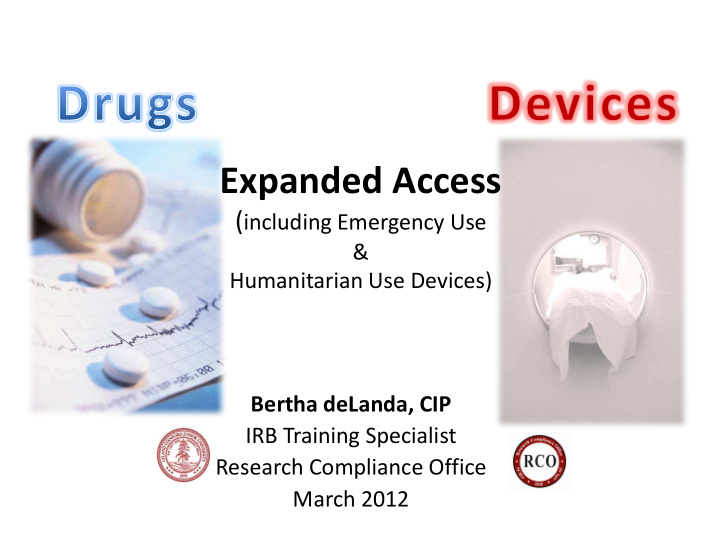



Expanded Access ( including Emergency Use & Humanitarian Use Devices) Bertha deLanda, CIP IRB Training Specialist Research Compliance Office March 2012
What Is Expanded Access? • Permits use of an investigational drug or device for treatment use, outside of a controlled clinical trial specific criteria reporting/monitoring requirements • 1° purpose : to diagnose, monitor, or treat a patient's disease/condition • For all expanded access use, prior IRB review and approval is needed (with the exception of Emergency Use) GUI-19m “Expanded Access to Investigational Drugs and Devices” http://humansubjects.stanford.edu 2
Drugs: Expanded Access 21CFR 312.300 (Subpart I) • Aim : To facilitate the availability of investigational drugs to patients with serious diseases or conditions when there is no comparable or satisfactory alternative therapy to diagnose, monitor, or treat them Immediately life-threatening disease or condition: There is reasonable likelihood that death will occur within…months or premature death is likely without early treatment Serious disease or condition: A disease/condition associated with morbidity that has substantial impact on day-to-day functioning. http://humansubjects.stanford.edu 3
DRUGS: EAP Categories Expanded Access Program Submission to FDA All 3 categories must Prior approval from the meet basic criteria in FDA is required for every 21 CFR 312.305(a) category of EAP 21 CFR 312.305(b) Intermediate-Size Treatment IND or Treatment Single (Individual) Patient Populations Protocol Patients (widespread treatment use) 21 CFR 312. 315 21 CFR 312. 310 21 CFR 312. 320 Includes EMERGENCY USE 21 CFR 56.102(d) http://humansubjects.stanford.edu 4
DRUGS: Expanded Access Criteria and Reporting/Monitoring Requirements (not a complete list) Criteria Reporting/Monitoring Patient(s)…have a serious/immediately life- Submission to the FDA threatening disease or condition, & there is may be a new IND , or no comparable or satisfactory alternative a protocol amendment to an existing IND Potential patient benefit justifies the potential risks, &…risks aren’t unreasonable in relation to disease/condition All require scheduled reporting to the FDA on This use won’t interfere with any ongoing follow-ups, progress, and clinical investigations that could compromise event notifications the marketing approval or potential development of EA use See GUI- 19m for additional criteria and requirements http://humansubjects.stanford.edu 5
Devices : Categories Continued Access Compassionate Use Single Patient/Small Group after the clinical trial Access under IDE is completed and Treatment Use (Treatment IDE) while the marketing Larger Group/More application is being Widespread Use prepared by the sponsor or reviewed by FDA Can also be Emergency Use 21 CFR 56.102(d) http://humansubjects.stanford.edu 6
Timeline for Device Development Continued Access Treatment Use Traditional IDE Study Emergency/Compassionate Use Before IDE IDE Approval IDE Completion Marketing Approval http://humansubjects.stanford.edu 7
Device: Expanded Access Criteria and Reporting/Monitoring Requirements (not a complete list) See GUI- 19m for additional criteria and requirements Criteria Reporting/Monitoring Existing concurrent clinical trial but Follow-up report Compassionate patient does not meet should be submitted Use inclusion/exclusion criteria to FDA as an IDE supplement No comparable or satisfactory Semi-annual Treatment Use alternative device/therapy to treat or progress reports 21 CFR 812.150(b)(5) diagnose that stage of the disease/condition Public health need or preliminary Request for Continued evidence of effectiveness extension submitted Access as IDE supplement All require scheduled reporting to the FDA on follow-ups, progress, and event notifications http://humansubjects.stanford.edu 8
Emergency Use Drug or Device Definition: The use of a test article on a human subject in a life-threatening situation in which: no standard acceptable treatment is available, and in which there is not sufficient time to obtain IRB approval. http://humansubjects.stanford.edu 9
Emergency Use of a Test Article GUI-6 Investigational drug, device, or biologic; Per 21 CFR 56.104(c) • The PD must submit the following to the IRB within 5 working days after use: APP-11m (Sections A, B, C, and D if informed consent was not obtained) Signed informed consents, if obtained Drug : PD/sponsor must submit IND/amendment to FDA within 15 working days (NEW REQUIREMENT) Device : when no IDE, PD must report to the FDA within 5 working days http://humansubjects.stanford.edu 10
Humanitarian Use Device GUI-36m • Humanitarian Use Device (HUD): A device intended to benefit patients by treating /diagnosing a disease/condition that affects fewer than 4,000 individuals in the United States per year. • Humanitarian Device Exemptions (HDE): Issued by the FDA; an approved HDE authorizes marketing of the HUD. • Application provides info for FDA to make certain determinations (e.g., risk/benefits). http://humansubjects.stanford.edu 11
Humanitarian Use Device , cont. GUI-36m • Requires IRB approval prior to use - subject to full review. • Clinical Use Subject to continuing review/approval. If applicable, the expedited procedure may be used at continuing review. A consent form is not required. • Research Use (if looking for a new indication) is considered a clinical investigation. http://humansubjects.stanford.edu 12
Resources GUIDANCE/HRPP GUI-6 – Emergency Use of a Test Article GUI-19m – Expanded Access to Investigational Drugs/Devices GUI-36m – Humanitarian Use Devices FAQs on our website at www.humansubjects.stanford.edu Chapter 5.8 HRPP, Expanded Access Chapter 5.9 HRPP, Emergency Use of a Test Article FDA Website Devices - http://www.fda.gov/MedicalDevices/default.htm Drugs - http://www.fda.gov/Drugs/default.htm NEW Brochure – Expanded Access to Investigational (Test) Articles http://humansubjects.stanford.edu 13
Recommend
More recommend